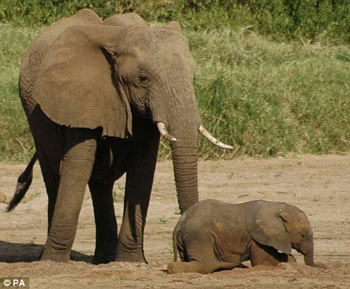Memory helps elephants to survive the survival war
In an environment where droughts often occur, elephants led by older children have a better chance of surviving, because they can remember places where there is plenty of food and water.
According to experts, drought will become more common in Africa due to global warming. In that context, only animals with experience dealing with droughts can survive for a long time.
Scientists from the London Association for Conservation of Nature and Animal Society study the problem by tracking the survival rate of baby elephants among three elephants in Tarangire Park during the 1993 drought.
They found that the number of dead elephants accounted for 20% of the total in the three groups - much higher than the 2% in the years without drought. However, the two elephants left the park with a lower elephant mortality rate. Their first two children are 38 and 45 years old, while the other herd is 33 years old.

The memory of the elephant's head increases the chances of the elephant's survival in drought conditions.Photo: dailymail.co.uk.
The team believes that the old elephants were able to remember the terrible drought earlier - which lasted from 1958 to 1961. At that time, the first two children to leave the national park were big enough to remember. events, while the leader of the herd stayed at the park born in 1960 so he could not remember anything.
"We deduce the age and the memories of the two leading children who left the park made a big difference from the flock. They remember the places where there are many food and water sources, so but the elephants are not hungry and thirsty, " said Dr. Charles Foley, lead researcher.
Researchers believe that the third group does not leave the park because their oldest children do not know where to have food and water outside the park.
According to Dr. Charles, in the context that drought has become more and more popular today, defending experienced children is one of the most important measures in the conservation of this animal.
- How to survive the apocalypse?
- Check the viability of people when they are in danger
- Diners become new threats of Thai elephants
- 10 secrets to survive and everyone needs to know to help you escape in a narrow distance
- Hormone detection helps recall memory
- The swimming book of the 16th century with many useful knowledge, helps to survive when entering the water
- Seven characteristics prove that elephants are extremely intelligent animals
- Scientists call for conservation of Vietnamese elephants
- 10 survival skills for lost forest goers
- Detecting microorganisms that live on ... 'arsenic' in the Pacific Ocean
- Listening or seeing helps you remember longer?
- Elephants have a very good memory?
 Animal 'suffering' after hibernation
Animal 'suffering' after hibernation Why do goats climb well?
Why do goats climb well? Scientists were surprised to see chimpanzees eating turtles
Scientists were surprised to see chimpanzees eating turtles Giant catfish died deadly due to drought in Thailand
Giant catfish died deadly due to drought in Thailand